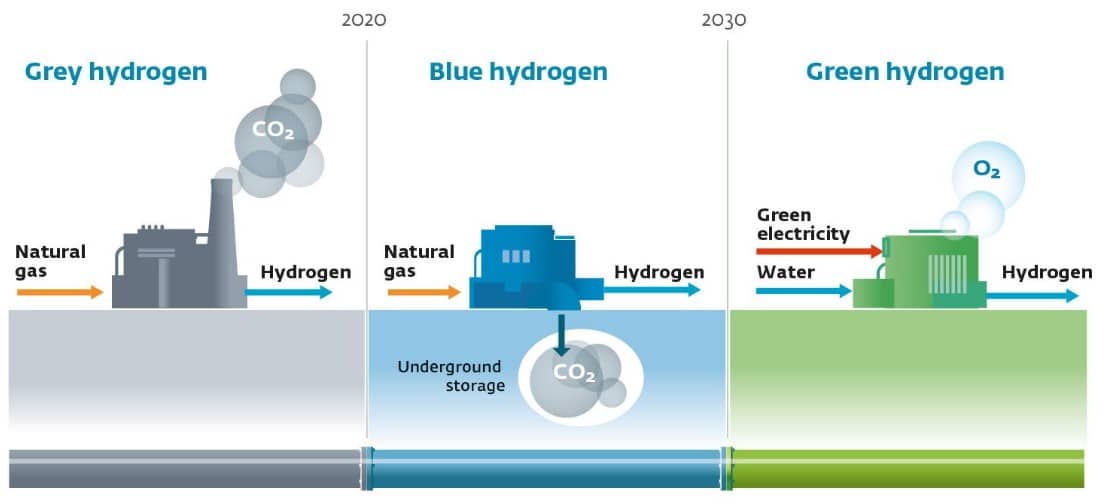What’s in today’s article?
- Why in News?
- What is green hydrogen?
- Where does India stand in the green hydrogen race?
- News Summary with respect to the National Green Hydrogen Mission
Why in News?
- The Cabinet Committee on Economic Affairs (CCEA) recently approved the National Green Hydrogen Mission (NGHM), with an initial outlay of Rs 19,744 crore, with the goal of making India energy independent and decarbonising major sectors of the economy.
- The PM first announced the NGHM in his Independence Day speech in 2021, after which the Ministry of New and Renewable Energy (MNRE) was tasked with developing a draft plan.
What is green hydrogen?
- Hydrogen gas (produced using industrial methods like electrolysis) can be used as a fuel and it does not release greenhouse gas (GHG) emissions such as carbon dioxide (CO2) when it is burned. Hence, a potential clean alternative to fossil fuels.
- Green hydrogen is the name given to hydrogen gas that has been produced using renewable energy, such as wind or solar power, which create no GHG emissions.
- Globally, most of the hydrogen produced today is used in the refining and industrial sectors – to make ammonia for the fertiliser industry, in the steel industry.
- In a fuel cell (device that converts the energy of a chemical into electricity), hydrogen gas reacts with oxygen to produce electricity and water vapour.
- By the end of the decade, the International Energy Agency (IEA) anticipates that hydrogen will find a host of new applications, including powering grids and fuelling the transportation sectors.
Where does India stand in the green hydrogen race?
Image Caption: India’s standing in global Green Hydrogen race
News Summary with respect to the National Green Hydrogen Mission
What is NGHM?
- NGHM is a key component in India’s attempt at energy transition from fossil fuels to renewables, with India announcing its new nationally determined contributions (NDCs) after COP 26 in Glasgow.
- India had committed to reduce emissions intensity of GDP by 45% by 2030 (from its 2005 level) and achieve about 50% cumulative electric power installed capacity from non-fossil fuel-based energy resources by 2030.
- The initial outlay of Rs 19,744 crore includes
- Rs 17,490 crore for the Strategic Interventions for Green Hydrogen Transition (SIGHT) programme,
- Rs 1,466 crore for pilot projects,
- Rs 400 crore for research and development, and
- Rs 388 crore towards other mission components.
- Under the SIGHT programme, two distinct financial incentive mechanisms – targeting domestic manufacturing of electrolysers and production of green hydrogen, will be provided.
- A public-private partnership framework for R&D (Strategic Hydrogen Innovation Partnership – SHIP) will be facilitated under the mission.
What are the potential benefits of NGHM?
- With NGHM, the government envisages the production capacity of low-cost green hydrogen to touch at least 5 MMT (million metric tonne) per annum by 2030, aiming to make India a global production-hub.
- The target of NGHM is to bring in an investment of Rs 8 lakh crore by 2030, and create over 6 lakh jobs, while reducing nearly 50 MMT per annum of CO2 by 2030.
- It also expects a cumulative reduction in fossil fuel imports of over Rs 1 lakh crore; create export opportunities; decarbonise industrial, mobility and energy sectors; develop indigenous manufacturing capabilities and cutting-edge technologies.
Conclusion
Green hydrogen is an expensive technology and the viability of this technology can be improved through government support for pilot projects and strategic interventions (especially on electrolysers) will improve feasibility of such projects.
Q1) What is a hydrogen fuel cell and how does it work?
Hydrogen fuel cells produce electricity by combining hydrogen and oxygen atoms. The hydrogen reacts with oxygen across an electrochemical cell similar to that of a battery to produce electricity, water, and small amounts of heat.
Q2) What is grey hydrogen?
Grey hydrogen is the most common form and is generated from natural gas, or methane, through a process called “steam reforming”. This process generates just a smaller amount of emissions than black or brown hydrogen
Source: Green hydrogen mission gets Cabinet nod, initial outlay Rs 19,744 crore | IE | The Third Pole | ACCIONA
Last updated on January, 2026
→ Check out the latest UPSC Syllabus 2026 here.
→ Join Vajiram & Ravi’s Interview Guidance Programme for expert help to crack your final UPSC stage.
→ UPSC Mains Result 2025 is now out.
→ UPSC Notification 2026 is scheduled to be released on January 14, 2026.
→ UPSC Calendar 2026 has been released.
→ UPSC Prelims 2026 will be conducted on 24th May, 2026 & UPSC Mains 2026 will be conducted on 21st August 2026.
→ The UPSC Selection Process is of 3 stages-Prelims, Mains and Interview.
→ Prepare effectively with Vajiram & Ravi’s UPSC Prelims Test Series 2026 featuring full-length mock tests, detailed solutions, and performance analysis.
→ Enroll in Vajiram & Ravi’s UPSC Mains Test Series 2026 for structured answer writing practice, expert evaluation, and exam-oriented feedback.
→ Join Vajiram & Ravi’s Best UPSC Mentorship Program for personalized guidance, strategy planning, and one-to-one support from experienced mentors.
→ UPSC Result 2024 is released with latest UPSC Marksheet 2024. Check Now!
→ UPSC Toppers List 2024 is released now. Shakti Dubey is UPSC AIR 1 2024 Topper.
→ Also check Best UPSC Coaching in India

















